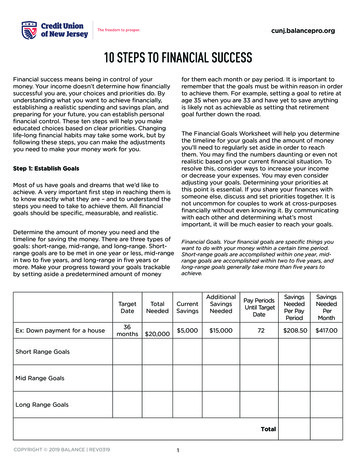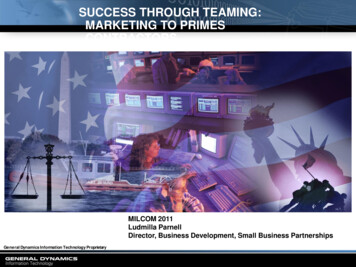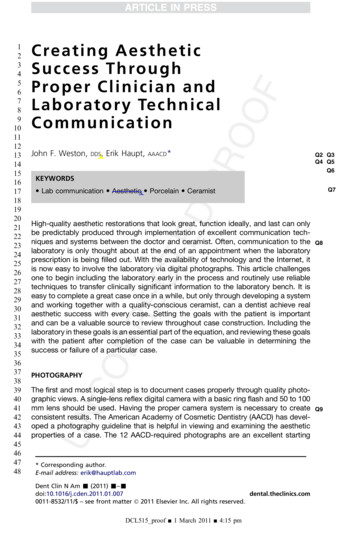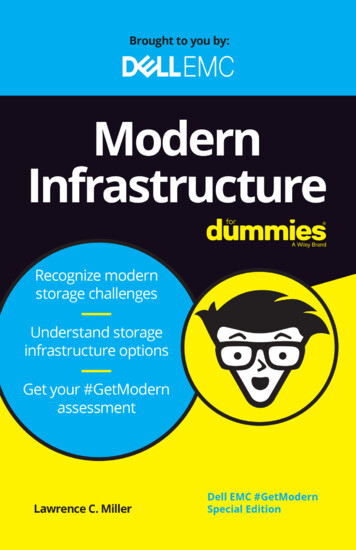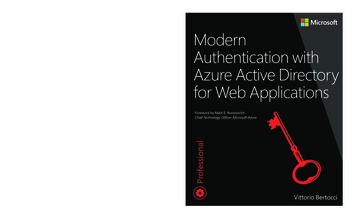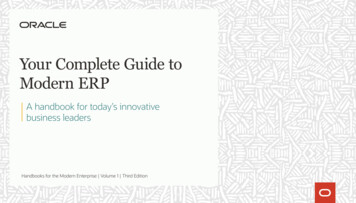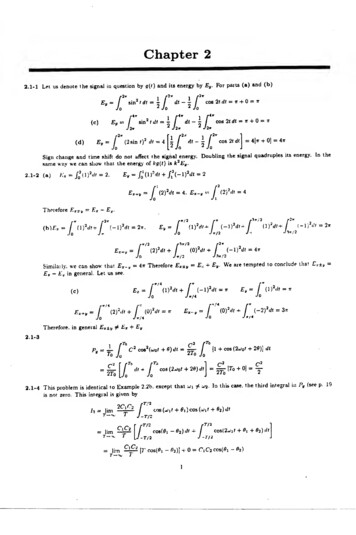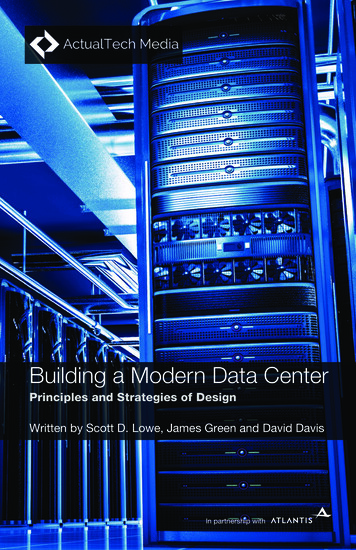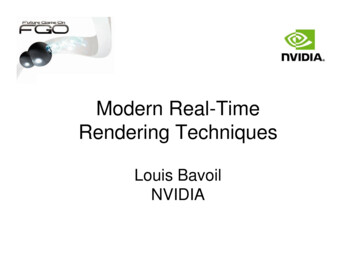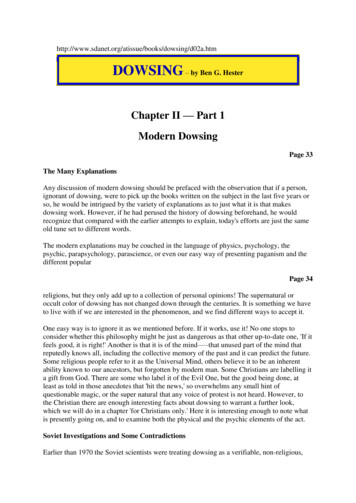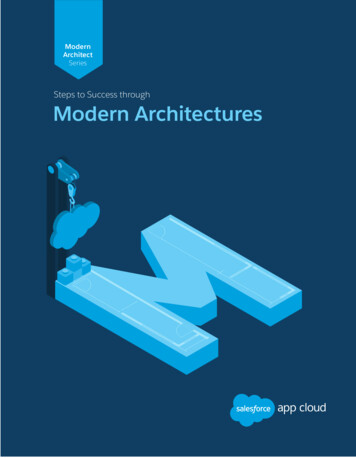
Transcription
ModernArchitectSeriesSteps to Success throughModern Architectures
Contents1Introduction2Target Operating Model3What’s Top-of-Mind?4Cloud Provider Capabilities5Data Management & Governance6Staffing & Skill Sets7Ongoing Operations
1. IntroductionModern Architectures” are a fresh look at how Enterprises pivot towardsthe future using both new and existing technologies, specifically cloudtechnologies.As Salesforce works with some of the largest brands and governmentagencies in the world, we have learned that cloud architectures are rootedin these basic realities:Agility as a Way of life: rapid prototyping, effective Product Owners, andvisible, defensible backlogs must be supported by the next wave ofpractitioners.Smart “Hybrid”: the data locked in on-premises and legacy systems needsbe quickly “surfaced” to the cloud through lightweight integration, “APIfirst” thinking, and in-memory analytics (which, in some cases, is cuttingdelivery to hours instead of months).Future-Proof by Design: changing process automation requirements, IoT,and other data-intensive trends are forcing architectures to evolve rapidly.Metadata-driven platforms provide the right flexibility to allow Architectsto act instead of react.Developer Democratization: conventional development approaches aregiving way to “composability” – drag-and-drop application assembly andfunctional components that can be “snapped” into the ecosystem. Toolingneeds to continually move up the “food chain” to allow quick assembly ofapplications instead of coding them from scratch.Salesforce.com Steps to Success through Modern Architectures1
As Enterprises commit to Modern Architectures, they are faced with a daunting set of decisions and conflictingmessages from cloud providers.This ebook introduces a simple, “survivable” framework briefly outlining an Enterprise journey through a numberof critical areas, associated aspects of each, and selected go forward best practices.Salesforce.com Steps to Success through Modern Architectures2
Many Enterprises continue to struggle with a number of key Business and IT challenges that are onlyexacerbated given the possibilities offered by cloud. It is critical that we understand the true “centers of thebullseye” by answering these questions:Backlog: Do you have one? What is the current set of initiatives, strategicprograms and associated success criteria to balance legacy requestswith new business? Taking a hard look at the backlog and settingregularly-reviewed priorities is a great way to zero in on what is reallyimportant, and course-correct as necessary.Agility Demands: Are you moving fast enough? What is the deltabetween the users’ need for change and IT’s ability to deliver? With nearly80% of current IT budgets dedicated to “keeping the lights on”, most ITdecision makers are concluding that rapid results imply leveraging cloud.Architects may have to socialize this message, especially for skepticalmanagement teams.Complexity of current portfolio: Does it fit your emerging needs? Howsurvivable is the current application and infrastructure portfolio? 30 years of .Net, Java, and similar “big stack” technologies may have servedthe business effectively in years past, but continued compatibilitychallenges and the plain fact that IT simply cannot sustain complexinfrastructures are leading to a fresh look at emerging trends, includingAPI-first and Microservices.Cost: How do you measure? What is the Enterprise’s cost basis forrunning IT? Companies often focus on “atomic” savings re: servers,storage, etc. While this can be an attractive component of the valueproposition, cloud is rarely a “zero-sum” game. The journey ofconsolidation, however, typically does result in drastic infrastructurereduction, but only in the medium-to-long term.Salesforce.com Steps to Success through Modern Architectures3
2. Target Operating ModelLarge-scale transformations can be challenging, especially across businessunits. Salesforce has found that successful cloud adopters are clear in theirstated approach to organize and conduct decision making, in the contextof cloud adoption. Let’s explore this further.Degree of Standardization of Business Processes: Enterprises are typically composed of business and serviceunits, municipalities, of agencies, and universities, of departments. However, the amount of processstandardization mandated by the lines of business sets a tone for technology consumption and governance.Degree of Integration of Business Processes: Integration of key processes is the other dimension to forming thetarget operating model. It sets the tone for the overall data strategy, influences the technical integrationapproach, and affects the level of what is practical from a design perspective.This leads to 4 distinct Operating Models*: Unification (High for Integration and Standardization dimensions) Coordination (High Integration, Low Standardization) Replication (Low Integration, High Standardization) Diversification (Low Integration, Low Standardization)The operating model typically indicates other impacts on cloud adoption, including the funding model (i.e.,budgets run out of the various agencies, Lines of Business (LOB) or department vs. Centrally funded) as well asthe Governance and Center of Excellence (CoE) Models. Salesforce typically sees the following types of CoEs:Consolidated: Centralized “Command and Control” across IT decision making.Federated: Centralized decision making for foundational technology approaches, with varying degrees of controlat the LOB level.*Enterprise Architecture as Strategy, J. Ross, P. Weill, D. Robertson, Harvard Business Press)Salesforce.com Steps to Success through Modern Architectures4
Confederated: “Laissez faire” or decentralized management and control (note: this is sometimes observed inearly-stage cloud adoptions, but quickly evolves into one of the other traditional models).Helping thousands of Enterprise customers, Salesforce has repeatedly observed that the lifecycle of a CoE can bea multi-year process: Enterprises can start small and simple and step into a more robust CoE model over time.Salesforce.com Steps to Success through Modern Architectures5
Business Process StandardizationLowHighCoordinationUnification Shared customers, products, suppliers Impact on other business unit transactionsHigh Operationally unique business units Autonomous business managementor global Globally integrated business processes withsupport of enterprise systems Business unit control over process design Business units with overlapping operations Shared customer/supplier/product data Centralized management applying Consensus process for designing overallmatrixed processes and functionsIT servicesBusiness Process Integration Customers and suppliers may be local High-level process owners design processes App decisions made in business units IT decisions made centrallyDiversification Few, if any, shared customers of suppliers Few, if any, shared customers Independent transactions Independent transactions aggregated at Operationally unique business unitsLowReplicationa high-level Autonomous business management Operationally similar business units Business unit control over process design Autonomous business unit leaders with Few data standards across business units Most IT decisions made within business unitslimited discretion Centralized control over process design Standardized data definitions but data locallyowned with some central aggregation Centrally mandated IT servicesWhat do we care? This area forces consideration of how the go-forward enterprise will truly function,including the effects of the funding model, governance processes, and transformation scope. It is aneffective check to remind everyone of the foundational design points of the future state of the business.Salesforce.com Steps to Success through Modern Architectures6
3. What’s Top-of-Mind?The application portfolio can be hugely impacted by compelling businessand technical events on the event horizon. In addition, systems arecontinually morphing, due to user requests and vendor updates.Salesforce has found that successful cloud adopters are clear in their stated approach to organize and conductdecision making, in the context of cloud adoption. Specifically:Key Systems near to “End of Life”: When legacy systems are no longer being supported by the vendor andplainly need to be decommissioned, this is a common trigger to consider a Modern Architecture-basedapproach.Major Systems to be Upgraded: Many Enterprises leverage a major upgrade to a source system (i.e., ERP) tore-evaluate their long-term direction and consider adding a layer of agility. They may choose to stay with thesource system, retire selected functions, or execute a complete sun setting program.New Programs: Key strategic initiatives may be straightforward candidates for cloud deployment (i.e., Mobile,311, Social, IoT, Big Data, large-scale new B2C offerings, etc.). Salesforce has seen this as a common bestpractice for Modern Architecture adoption.Suitability Criteria: As applications are evaluated for cloud deployment, Enterprises can determine suitabilitybased on a simple set of criteria:What are the audiences: B2C, B2B, B2B2C? “Elastic” or unknown scale use cases are perfect to pilot in thecloud, as they can be massively scaled with near-zero effort and no capital outlay.What are the requirements including time to market, data residency and volume, and rate of change? Thesecriteria can be “heat-mapped” against business priority to help flush out a set of go-forward priorities.Salesforce.com Steps to Success through Modern Architectures7
Which Integration Patterns are involved?Designers can catalog the prevalent data accessmethods they require (asynchronous vs.synchronous, data volumes, exception handling)and then map them against the available toolset.Why do we care? This analysis quicklyidentifies those programs that arebetter or worse candidates for cloudalong with high-level applicationdesigns and a go-forward roadmap,increasing the likelihood of success.Salesforce.com Steps to Success through Modern Architectures8
4. Cloud Provider CapabilitiesTrust continues to be common red flag for cloud adoption for Enterprisesof all sizes. While all cloud vendors have had to address this key issue,Salesforce has seen that the most successful cloud adopters engage cloudproviders with a list of known requirements, and closely partner tounderstand their capabilities and forge joint approaches:Trusted Security: This includes a layered security approach at both application and the infrastructure level.Enterprises need to understand the key demarcations at each layer of both levels, and understand any gapsand associated risk mitigation needs. Also critical here are the specific compliance requirements (ISO 27001,SOC 13, TRUSTe, FedRAMP, PCI, HIPAA) as well as Monitoring, Encryption-at-Rest, and other security topics.“Always On” Availability: As Enterprises adopt cloud and hybrid postures, an obvious requirement is availability.How are the candidate providers ensuring reliability, business continuity and transparency of their services,and now are updates handled?Performance at Scale: Market leading cloud providers are continually adding capacity, but Enterprises need tobe assured that performance will continue to improve, especially at scale. As multi-cloud, compositeapplications continue to proliferate, each link in the chain needs to be performant and scalable.(Secure) Application Innovation: Enterprise adoption of cloud approaches occurs for many reasons beyondsimple cost savings. Most transformations are centered on innovation and speed and involve emerging bestpractices including “API First” and Microservices.Approach to Multitenancy: Is the Enterprise comfortable with a multitenant approach? Oftentimes, there needto be multiple discussions between technical, business and cloud provider leadership to fully understand thebenefits of multitenancy and how data is kept operationally safe and technically segregated.Salesforce.com Steps to Success through Modern Architectures9
Why do we care? This major area helps to lay out the basic requirements that the cloud vendor andEnterprise need to jointly adhere to. Note that Enterprises may not know all of these requirements apriori - cloud policies tend to expose and clarify many emerging requirements! Such discussions alsohelp Enterprises to balance practical approaches with their critical needs.Salesforce.com Steps to Success through Modern Architectures10
5. Data Management & GovernanceBusiness data is the lifeblood of the Enterprise, and the pivot to ModernArchitectures demands that new applications and approaches do notjeopardize its management. Salesforce advises our customers to explorethese data-focused areas as they continue their cloud adoption journey:What are the Impacts to Systems of Record (SoR)?: This includes data residency, integration patterns (i.e., ETL,batch vs. near real-time, etc.). As new apps (including mobile and analytics) accelerate, a clear line of sightbetween the SoR and the app needs to be drawn. Salesforce has seen that, in many cases, data-by-referenceapproaches (including OData) are an effective way to quickly deliver value with minor SoR impact.What are Data Lifecycle Approaches? While many cloud adoptions can get mired in “customer master”discussions, oftentimes simpler, achievable "good enough" data approaches can build momentum when usedwith an agility layer. This means that instead of waiting for traditional “golden record” approaches, ITcan quickly deliver apps and continually improve the quality and currency of the data.What about Internal Infrastructure Requirements? Enterprises need to rationalize internal data internal policiesand “hard” infrastructure impacts (firewall policies, logging, exception handling). Salesforce has seen that suchpolicies are often out of date
Salesforce.com Steps to Success through Modern Architectures 8 Which Integration Patterns are involved? Designers can catalog the prevalent data access methods they require (asynchronous vs. synchronous, data volumes, exception handling) and then map them against the available toolset. Why do we care? This analysis quickly
